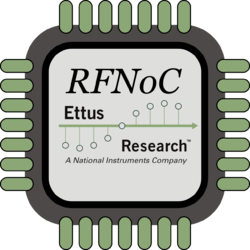Difference between revisions of "RFNoC (UHD 3.0)"
From Ettus Knowledge Base
(added link to where you can find all current noc_blocks....) |
(→Overview: More technical, less marketing) |
||
| Line 1: | Line 1: | ||
==Overview== | ==Overview== | ||
{| | {| | ||
| − | |style="vertical-align:top; width: 60%;"| | + | |style="vertical-align:top; width: 60%;"|RFNoC is a network-distributed heterogeneous processing tool with a focus on enabling FPGA processing in USRP devices. It allows you to move data on and off of an FPGA in a transparent way, thus enabling seamless use of both host-based and FPGA-based processing in an application. The result is a much simpler way to leverage FPGA processing capabilities and IP in your application which can scale across multiple FPGAs and devices across a network. |
| + | |||
| + | Signal processing algorithms are contained modules known as "Computation Engines" or "NoC Blocks", and an interface wrapper is provided to encapsulate existing or external IP to use with RFNoC. This allows you to import Xilinx™ CoreGen™ IP blocks, for example, and use them immediately in your RFNoC application. The internals of a NoC block are wholly independent from any other block, and can be designed with any tool that supports AXI stream interfaces, including VHDL, Verilog, and Xilinx™ Vivado™ HLS. | ||
| + | |||
| + | We are quickly building out the library of ready-to-use NoC blocks and already have many available, including the blocks necessary for an OFDM stack (e.g., detection, synchronization, equalizer, packet demodulator). | ||
| + | |||
| + | RFNoC is integrated with the UHD™ software, and all USRP devices from the third-generation on (X300 Series, E300 Series) are supported by RFNoC out-of-the-box. Like UHD, RFNoC is also Free and Open Source Software, and the full source code can be found in our public code repositories. | ||
||[[File:rfnoc.png|250px]] | ||[[File:rfnoc.png|250px]] | ||
|} | |} | ||
Revision as of 12:37, 28 December 2016
Overview
Supported Devices
- E310/E312
- X300/X310
Sample of Available Blocks
- FIFO
- FFT
- FIR
- fosphor (real-time spectrum analyzer)
- Decimator (Keep 1 in N)
- Log Power Calculator
- Radio Interface
- Vector IIR (moving average)
- Window multiplier (for FFT)
- OFDM: Burst detection + synchronization, equalizer, packet demodulator
- and more...
RFNoC Resources
2016
- Getting Started with RFNoC Development with PyBOMBS
- Getting Started with RFNoC Development
- GNU Radio 2016 Conference Presentation
2015
- Virginia Tech Video Presentation
- Virginia Tech Presentation - Introduction to RFNoC
- Virginia Tech Presentation - RFNoC Deep Dive: Host Side
- Virginia Tech Presentation - RFNoC Deep Dive: FPGA
2013

